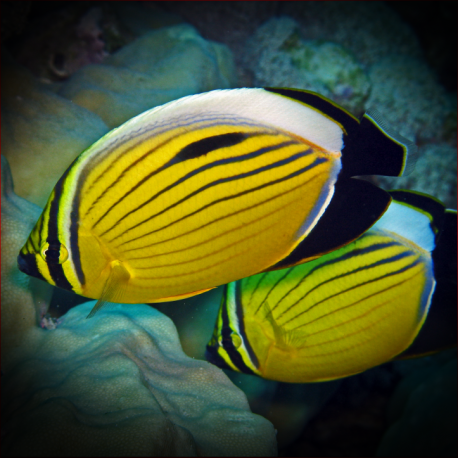More info
Datasheet
| Minimum Tank Size | 300 litres / 79.25 US gallons |
| Maximum Size | 13.0cm / 5.12inches |
| Reef Compatible | Not reef safe |
| Temperament | Mostly peaceful but might be aggressive towards similar species |
| Temperature | 22.2°C / 71.96°F - 25.6°C / 78.08°F |
| Specific Gravity | 1.020-1.025 |
| Carbonate Hardness | 8-12 |
| pH | 8.1-8.4 |
General Description
The Blacktail Butterflyfish, scientifically known as Chaetodon austriacus, belongs to the Chaetodontidae family. It is part of a complex of species within the Chaetodon genus that share similarities in appearance but have varying needs, making it essential to differentiate among them. This species is characterized by its striking patterns and vibrant colors, typical of Butterflyfish, a group closely related to Angelfish but distinguishable by the absence of head spines. Chaetodon austriacus is native to the Western Indian Ocean, specifically the Red Sea and the Gulf of Aden.
Aquarium Suitability
With an average hardiness level, the Blacktail Butterflyfish is not deemed suitable for home aquariums due to its specialized diet mainly comprising live coral polyps. Notably, this species cannot survive on substitute foods and will only thrive if provided with live corals, making it challenging to maintain in captivity unless coral feeding is an option. It is often recommended to introduce this butterflyfish as a pair simultaneously, and they require ample swimming space along with hiding spots like live rocks within the tank.
Care and Hardiness
This Butterflyfish species requires careful attention due to its specific dietary preferences, making it crucial to ensure the availability of live coral polyps. Acclimatizing them to captive environments can be arduous, emphasizing the importance of procuring healthy specimens initially to evade potential issues. They are generally peaceful towards other fish but might exhibit aggression towards similar species, suggesting caution when housing multiple Blacktail Butterflyfish together unless they form a bonded pair.
Reef Suitability
Regarded as not reef-safe, the Blacktail Butterflyfish does not lend itself well to reef environments due to its coral-centric diet. It can pose a threat to clams, such as Tridacna species, by nibbling on them, along with a penchant for consuming tubeworms. In reef setups, this species is incompatible unless a dedicated coral-feeding strategy is implemented.
Aquarium Setup
To accommodate the needs of the Blacktail Butterflyfish, a minimum tank size of 300 liters is recommended, providing ample space for swimming. The aquarium should offer hiding places like live rocks and cater to the fish's proclivity for swimming, necessitating a setup that balances open areas for movement with suitable shelter options. Maintaining water conditions within the specified ranges of pH (8.1-8.4), temperature (22.2-25.6°C), carbonate hardness (8-12 dKH), and salinity (1.020-1.025) is crucial for their well-being.
Behaviour
Blacktail Butterflyfish are mostly peaceful inhabitants but can display aggression towards similar species, especially if not in a bonded pair. Their behavior includes a preference for swimming in open spaces while also seeking out hiding spots for security. Careful observation of their interactions with tank mates is advised to prevent potential conflicts in a mixed-species environment.
Feeding and Diet
This species predominantly feeds on coral polyps, emphasizing the challenge of meeting its dietary requirements in captivity. Their highly specialized diet necessitates the provision of live SPS (Small Polyp Stone) coral specimens to sustain them. While some individuals may adapt to frozen foods, most Blacktail Butterflyfish struggle to accept substitutes, making their feeding habits a crucial consideration for prospective keepers.
Dimorphism
Information regarding dimorphism is unavailable, and captive reproduction is not covered for this species of Butterflyfish.
Habitat and Distribution
In its natural habitat within the Red Sea and the Gulf of Aden, the Blacktail Butterflyfish inhabits coral-rich environments where it can feed on a variety of coral polyps. Their distribution is limited to the Western Indian Ocean, specifically these regions characterized by diverse coral ecosystems that support their specialized dietary preferences.

